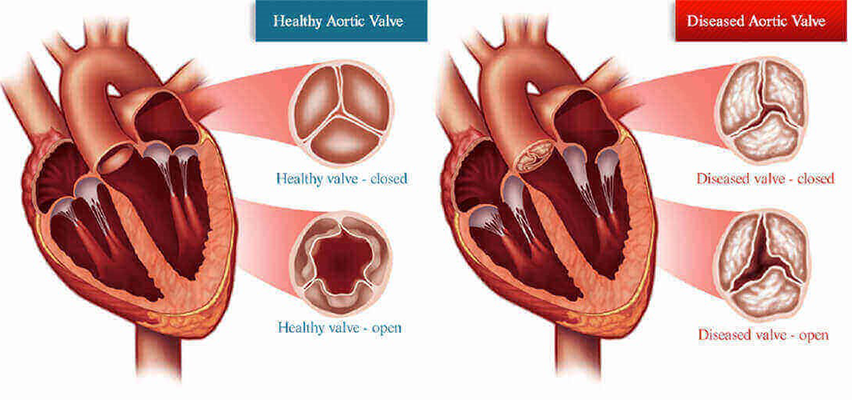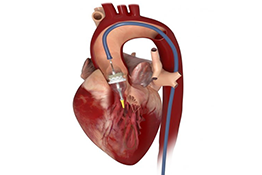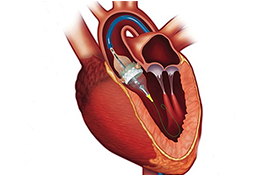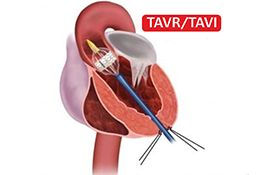
TAVI Heart Surgery in Delhi
TAVI, or Transcatheter Aortic Valve Implantation, is a medical procedure that
involves inserting a new valve without removing the old one. This procedure is
recommended if your aortic valve is dysfunctional (Severe Aortic Stenosis). Once the
new valve is installed, it pushes the old valve parts out of the way, allowing the
tissue in the replacement valve to regulate blood flow.
TAVI is also known as Transcatheter Aortic Valve Replacement (TAVR). TAVI and TAVR
are identical procedures; they simply have different names.
TAVI is a common and relatively painless procedure. A narrow flexible tube (known as
a catheter) is inserted into a blood vessel in your upper leg or chest and guided to
your aortic valve in your heart. The tube is used to install a replacement valve on
top of your existing one.



Why do you need a TAVI?
If you have aortic stenosis, your aortic valve does not open completely.
Your heart valves help keep blood flowing through your heart. The aortic valve
opens, allowing blood to flow from your heart into your aorta. The aorta is a large
vessel that supplies your body with oxygen-rich blood.
If you suffer from severe aortic stenosis, your aortic valve may need to be
replaced.
TAVI was initially used as an alternative to heart valve surgery for patients who
were unable to undergo open heart surgery to replace their aortic valves. However,
TAVI is now being used for people who are at a lower risk of complications from
heart surgery because studies show it is at least as effective as heart valve
surgery after a year. TAVI is also demonstrating long-term efficacy, but more
research is needed before it becomes the first option for patients with severe
aortic stenosis.
How successful are the TAVI procedures?
In most cases, people report that their symptoms improve after a TAVI procedure, allowing them to do more in their daily lives. A smaller number of people may experience complications following a TAVI procedure. The risk varies according to your overall health and your specific heart condition.
Making healthy lifestyle changes can improve your chances of long-term success and reduce the risks of TAVI.
- Eating healthier
- Becoming more physically active.
- Giving up smoking
- Cutting back on alcohol
- Taking prescribed medications
How long do TAVI heart valves last?
More research is required before we can say with certainty how long TAVI valves typically last. Most people's TAVI valves will still be in good condition six years after their procedure. This will most likely improve as techniques and technology advance.
What are the benefits of TAVI?
The benefits and risks of TAVI are changed to each individual and are determined by the severity of your aortic stenosis, age, and overall health. TAVI can provide the following benefits:
- Relief or reduction in pain (if you had angina)
- Relief from or reduction in breathlessness
- Relief from or reduction in tiredness
- Benefits include reduced dizziness and fainting and increased energy levels. Better blood flow through your heart makes daily tasks and physical activities easier and more enjoyable.
- improved mood and mental health.
- decreased risk of heart failure and death.
TAVI offers several advantages over open heart aortic valve surgery, including:
- Less risk of death and strokes
- A shorter hospital stay
- Faster overall recovery
What are the risks of TAVI?
All medical procedures carry risk. Some of the most common complications
associated with TAVI include:
Possible complications of catheter insertion include irregular heart rhythm,
bleeding, bruising, damage, or infection in the upper leg or chest area. Pacemakers
may be necessary.
Blood clots and stroke However, following TAVI, you will be given anti-clotting
drugs to reduce your risk.
All medical procedures carry risk. Some of the most common complications associated
with TAVI include:
Possible complications of catheter insertion include irregular heart rhythm,
bleeding, bruising, damage, or infection in the upper leg or chest area. Pacemakers
may be necessary.
Blood clots and stroke However, following TAVI, you will be given anti-clotting
drugs to reduce your risk.
What happens during TAVI?
A TAVI procedure typically takes between one and two hours, but it may take longer in some cases. During the procedure, you will usually be awake but will be sedated and given local anaesthesia. More rarely, you may be put under general anaesthesia.
- You will be asked not to eat or drink for four to six hours prior to the TAVI procedure.
- You'll change into your gown and be asked to remove any jewellery that could get in the way.
- You will usually be awake and lying on your back during the TAVI. You will be given a medication called a sedative to help you relax.
- You will receive a local anaesthetic injection to relieve pain in your upper leg and under your collarbone. A thin tube (the catheter) is then passed into your artery via the numbed area.
- The tube is then passed into the opening in your aortic valve, and a new valve, made of metal and animal tissue, is placed inside the old valve.
- The valve either expands on its own or a balloon at the end of the catheter tube can be blown up to make room for the new valve.
- Many people feel pressure during the TAVI. If you feel unwell or have chest pain at any time, please notify the team.
- Following the procedure, the catheter tube is removed, and there may be some bleeding.
- You will then return to the recovery room and, a few hours later, be transferred to the ward.
- You usually leave the hospital after a day or two, but discharge times can vary for everyone.
Your TAVI procedure will take place in a cath lab, which is a sterile room in the hospital that resembles an operating room.

